St. Fortchern (Fortiarnan) – Trailblazer of the Irish Saints
St. Fortchern (from the Gaelic, Fortiarnan) was one of the first Irish monks. His love of learning, and his contribution to ecclesiastical art, laid much of the foundations of early Irish Christian culture. Christopher McQuinn looks at the life and legacy of a remarkable pioneer.
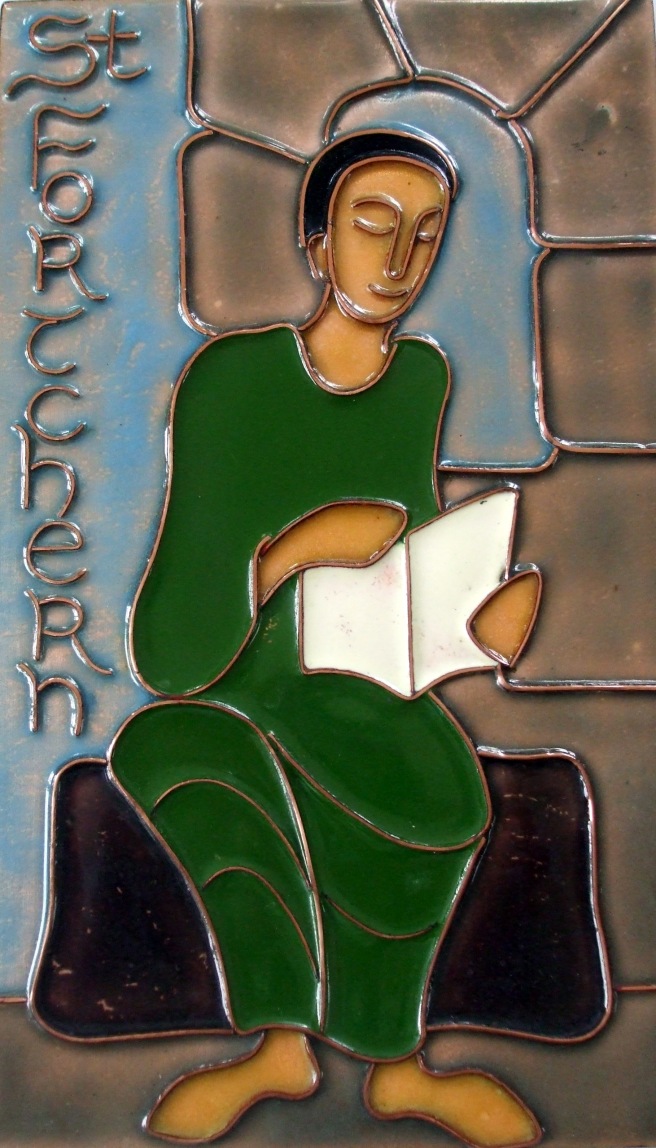
Enamel by Anne Murphy – www.eala-enamels.com
He was of royal Irish and Welsh blood, a youthful convert to Christianity, and a pupil of St. Patrick and of Patrick’s nephew, St. Loman. Reluctantly agreeing to succeed Loman as Abbot and Bishop, he resigned after just three days. A hermit, a scholar who founded one of Ireland’s first monastic seats of learning, an academic who provides a link between St. Patrick and St. Columba, an outstanding craftsman, the Patron Saint of Bell Founders, honoured by Latin, Orthodox and Coptic Churches, St. Fortchern, has, over the centuries, been largely forgotten by the general public, and his importance in the story of the spread of early Irish Christianity has been overlooked.
The Early Years
Fortchern was born in Trim in the early fifth century. The Gaelic version of his name, Fortiarnan, means “overlord”.
Known as the Prince of Trim, Fortchern was the son of a chieftain, Feidhlimid, son of Laoire, the Ard-Ri (High King), who was a son of Niall of the Nine Hostages.[1]
Fortchern’s mother was a Welsh princess, named Scothnach, daughter of King of the Britons. The Welsh name for Fortchern is Vortigern or Cwrtheyrn. Gwrtheyrion was a Welsh kingdom, in the Powys area, named after Cwrtheyrn, who may have been Fortchern, or one of his relatives.[2]
St. Patrick
St. Patrick embarked on his mission to evangelise the Irish in or around what was traditionally held to be 432 A.D. He and his followers first made an unsuccessful attempt to preach the Gospel after landing at Arklow. This setback was due the opposition of the local king, Eanna who was called Chinseallaigh. The missionaries re-embarked and entered the mouth of the River Boyne. St Patrick’s nephew, St. Loman was left in charge of the boat, while Patrick and the other missionaries went on with their work of converting the local chieftains and people to the Gospel.
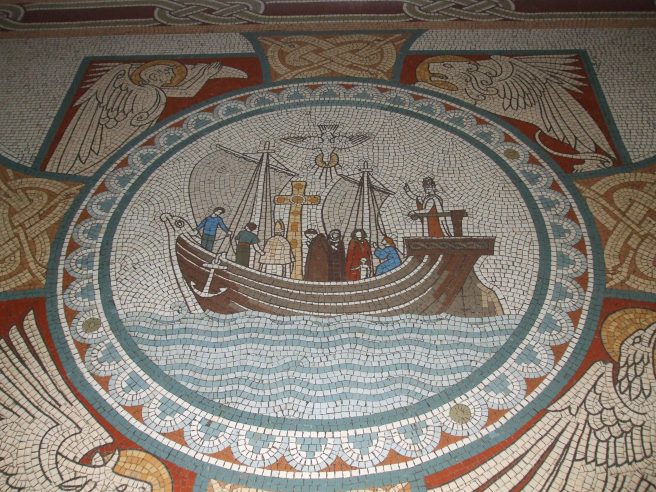
Mosaic depicting St. Patrick landing at Trim, Church of St. Patrick, Trim
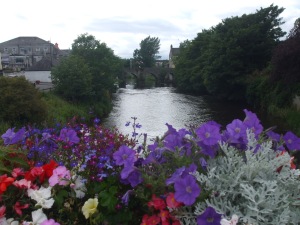
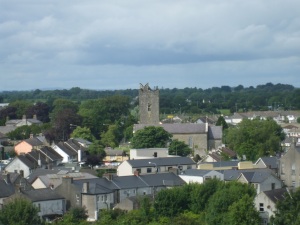
Fortchern, protesting that it was not right to be Bishop of what had been his father’s territory, reluctantly accepted the nomination. However Fortchern remained bishop for only three days, withdrawing to the kingdom of Ui Drona in South Leinster to lead the life of a hermit.
Killoughternane
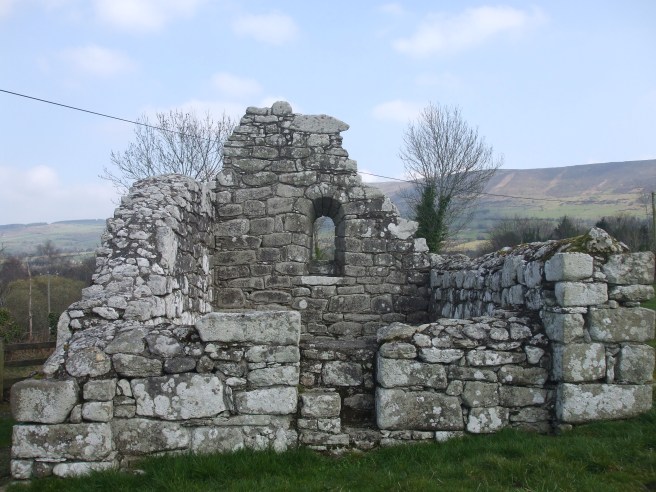
Ruins of church in Killoughternane, dedicated to St. Fortiarnan
This hermitage site became known as Killoughternane (Cill Fhortiarnain or Cill Uachtarnain), and is near Muinebeag (Bagenalstown). The remains of a church, dating from the 10th or 11th century mark this site.
Soon local chiefs and others sent their children to be educated in the new religion by St. Fortiarnan.
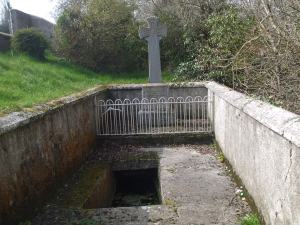
St. Fortiarnan’s Holy Well, Killoughternane
In a field across the road from the church ruins in Killoughternane is St. Fortchern’s Holy Well, which was famous for its cures. In the nineteenth century a local woman, Mrs. Betty O’Hara, cleaning the well, found a chalice and paten. Underneath the foot of the chalice is the Latin inscription: “ F. Joannes me fieri fecit cum licentia superiorem 1595, ora pro eo.” This translates as: “Fr. John Lucar had me made with the permission of his superiors in 1595, pray for him.” Fr. Lucar was a Franciscan priest from Waterford. These artefacts may have been hidden in penal times by a priest who was celebrating Mass nearby. [4] Given St. Fortiarnan’s fame as a maker of sacred vessels, it is remarkable that a chalice from Tudor times be discovered in his well.
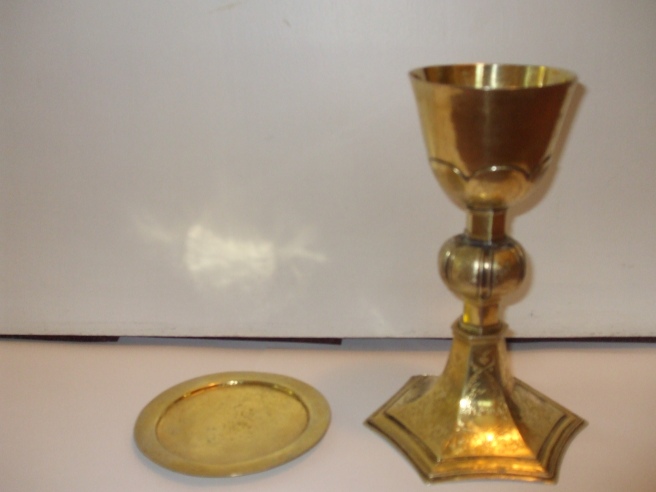
Killoughternane Chalice & Paten
Tullow
St. Fortchern went on to establish a church and school at Tullow. The site he selected may have been beside the River Slaney[5], at Our Lady’s Well on the Ballymurphy Road.[6] No traces of this monastic school remain although the large granite cross base and font in the churchyard of the present St. Columba’s Church of Ireland may be associated with the early monastery.[7]. Other local historians have suggested Crosslow as the possible site of his monastery.
Font and base of celtic cross, St. Columba’s Churchyard, Tullow, County Carlow
The school became so famous that the area was known as Tulach Fhortiarnain or Tulach Fortchern.[8] In later years the area was renamed Tulach O bhFeidhlim.
St. Finnian
One of Fortiarnan’s greatest pupils was Finnian, a native of Myshall. St. Finian was placed under the care of St. Fortchern, probably at Tullow, until he was aged 30 years. [9] Doubtless due to St. Fortchern’s Welsh family connections, Finnian then spent several years in St. David’s Monastery in Wales, where he studied under St. Cadoc and St. Gildas. On his return to Ireland Finnian founded monasteries at Aghowle, Munny and Clonard.
Not far from Killoughternane is Templemoling Cemetery, Ballinree, an early church site associated with St. Moling. One can find here a stone reputed to show the footprint of St. Finian.[10]
Fortchern – a link between Patrick and Columba
Clonard became a great centre of learning, especially of Bible Studies. Finnian was a renowned Biblical scholar. He is often called “the Teacher of the Irish Saints,” and the “spiritual father of three thousand monks”[11], which included the “twelve apostles of Ireland.” A pupil of St. Finnian in Clonard was St. Colmcille, also known as St. Columba (who was also a relative of St. Fortchern, both being descended from Niall of the Nine Hostages)[12]. St. Columcille founded the monastery of Iona, and is one of Ireland’s three patron saints, the others being St. Patrick and St. Brigid. Thus St. Fortchern provides a link between St. Patrick, the apostle to the Irish, and St. Colmcille, the first great Irish missionary.
Fortchern – Craftsman
St. Fortchern was known as the “smith of Patrick”:
“His three smiths, expert at shaping,
Macecht, Laebhan, and Fortchern.” [13]
The Laebhan mentioned here is identified as St. Loman.[14]
Fortchern was famous for his skill in metalwork, which he used in the making of sacred vessels, statues, crosses and bells. The art of casting bells for use in Christian churches started with the Coptic monks in Egypt long before 500 AD. Irish monks learned it from them. Before long the Irish had some distinguished bell-founders, the most prominent being St. Fortchern, who is the Patron Saint of bell- founders.[15] It was only much later that the job of casting bells passed from monks to professional bell-founders. The custom of ringing bells from specially built towers spread from the 6th Century on.
It was also Fortchern who fashioned the famous image of the Madonna which was enshrined for centuries in the Monastic Chapel at Trim[16]. In Tudor times the Reformers in Ireland “burned the celebrated image of Mary at Trim, which used to perform wonders and miracles.” [17]
Fortchern is depicted as a craftsman in the stained glass window of the Church of the Sacred Heart in Borris.
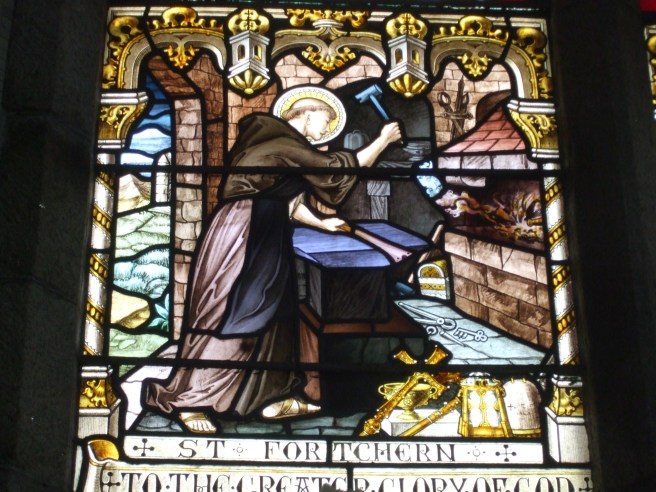
St. Fortchern, shown as craftsman, in the stained glass window in the Church of The Sacred Heart, Borris, Co. Carlow. Note the sacred items on the bottom right.
St. Lassara
St. Fortchern had a niece, named Lassara, who also became a saint. Her name comes from the Old Irish word for flame. She was highly educated in scripture in Clonard by St. Finian, who placed her under the care of St. Kieran. St. Kieran later went on to found the famous monastic seat of learning at Clonmacnoise. The feast day of St. Lassara is the 29th March[18].
Holy Wells
The sites of early Irish churches were generally near a well or stream of pure water, which might serve as a baptistery for the new congregation. These wells were first blessed by St. Patrick or his successors, as they might have been previously used as a sacred well by Druids. “Then the Catechumens, as they were ready, were brought in batches, made to stand up to their knees in the well or stream and the apostle and his assistant priests pouring the living stream on their heads, ransomed them from the powers of darkness, and made them heirs to the kingdom of light.”[19]
Patterns
Pattern days were historically religious occasions. People made a penitential pilgrimage to a holy well of a particular saint on the saint’s feast day. The word pattern is a standard corruption of the Irish patrun, meaning patron. Having lasted since earliest times, many patterns died out in the early part of the nineteenth century. Killoughternane, however, still celebrates its Patron, St. Fortchern, on the evening of the last Friday of each July. The parish of Tullow had three pattern days: St. Torannan on the 12 June, St. Fortchern on 12 October, and the feast of the Assumption on 15 August.[20] St. Torannan died in the year 634. [21] Tullow pattern days had an accompanying fair on the same day.
Our Lady’s Well at Tullow, one of three reputed holy wells,[22] for long remained a site of such pilgrimage.
Our Lady’s Well, Ballymurphy Road, Holy Well, St. Austin’s Graveyard, and Joseph’s Well, Hillbrook, Tullow
Comerford quotes from the Name Book; “Lady’s Well- Formerly the Patron Well of Tullow; two trees, one growing on each side thereof; the water of which is reputed to have been good for the cure of all diseases. The Patron has been discontinued and a fair held on 8th September, substituted in its place, called the Patron Fair.” [23] The well was finally forgotten until it was excavated, and the present shrine erected in the 1920s by Bro. Leo Slattery and the boys of the National School with the help of some others.[24]
Fortchern’s’s Death
When Fortchern resigned as Bishop of Trim, he said that he would never return there alive. After his death in 500 A.D. St. Fortiarnan’s body was returned to be buried among his own people in Trim.
A VERSION OF THE ABOVE ARTICLE FIRST APPEARED IN CARLOVIANA 2011, AND IS REPRODUCED WITH PERMISSION OF THE EDITOR.
BIBLIOGRAPHY
Comerford, M. (1886) Collections relating to the Dioceses of Kildare and Leighlin. Vol. III. Dublin: James Duffy and Sons
Cunningham, B. (2010) The Annals of the Four Masters. Dublin: Four Courts Press
Dalton, E.A. (1911) History of Ireland. Vol.1. London: The Gresham Publishing Company
Failte Ireland (2010) Carlow- trails of the saints. Carlow: Carlow County Council
Healy, J. (1890) Insula Sanctorum et Doctorum or Ireland’s Ancient Schools and Scholars. Dublin: New York: Sealy, Bryers, & Walker
McGrath, T. (1999) Religious Renewal and Reform in the Pastoral Ministry of Bishop James Doyle of Kildare and Leighlin, 1786 – 1834. Dublin: Four Courts Press
Moore LT, McEvoy B, Cape E, Simms K, Bradley DG (2006) A Y-Chromosome Signature of Hegemony in Gaelic Ireland, American Journal of Human Genetics 78(2)
O’Hanlon, J. (1875) Lives of the Irish Saints. Vol. 3. Dublin: James Duffy and Sons
Tommasini, A.M. (1937) Irish Saints in Italy. London: Sands and Company (Publishers) Ltd.
1 Annals of the Four Masters, entry 432.3
[2] www.vortigernstudies.org.uk, August Hunt, The Myth of the British Vortigern
[3] Book of Armagh, fol.16
[4] www.myshaldrumphea.com Website of Myshall Drumphea Parish
[5] E.A. Dalton. History of Ireland, Vo1.1, p.58 states that monks generally settled near a river.
[6] Bro. Linus Walker F.S.P. Land of Saints
[7] Failte Ireland, Carlow – trails of the saints, p. 14
[8] Comerford. M., Collections Dioceses of Kildare and Leighlin Vol. III, p.387.
[9] Rev. John Healy, Insula Sanctorum et Doctorum or Ireland’s Ancient Schools and Scholars, quoting Loca Patriciana, p. 152
[10] Failte Ireland, Carlow – trails of the saints, p.32
[11] Acta SS. P 365
[12] Moore LT et al. p.334-8, in a 2006 TCD DNA study found that 21% of men in NW Ireland (seat of the Ui Neill), and 8.2% of men in the island of Ireland, belonged to R1b3 haplogroup, showing descent from a common ancestor, probably, Niall of the Nine Hostages
[13] Annals of the Four Masters, entry 448
[14] www.vortigernstudies.org.uk Hunt op. cit.
[15] www.vsl.co.at Website of Vienna Symphonic Library
[16] Cunningham, The Annals of the Four Masters, p.116 states that accounts of miracles wrought by the image of the Virgin Mary in Trim are found in the Annals of the Four Masters, the Annals of Ulster and the Annals of Connacht.
[17] Annals of the Four Masters, V, 1445-9, quoted Fra. A.M. Tommasini Irish Saints in Italy
[18] John O’Hanlon, Lives of the Irish Saints, Vol. 3. p. 996
[19] Michael Comerford, Collections relations to diocese of Kildare and Leighlin Vol. 3, p. 92, quoting Right Rev. Dr. Healy, Coadjutor Bishop of Clonfert, Irish Monthly, February 1884
[20] Thomas McGrath, Religious Renewal and reform in the Pastoral Ministry of Bishop James Doyle of Kildare and Leighlin, 1786-1834, p. 175
[21] Michael Comerford, op. cit 387
[22] Thomas McGrath , op. cit. p. 174
[23] Michael Comerford, op. cit. p. 389
[24] Bro. Linus Walker, op. cit.






2 thoughts on “St. Fortchern – patron of Tullow”